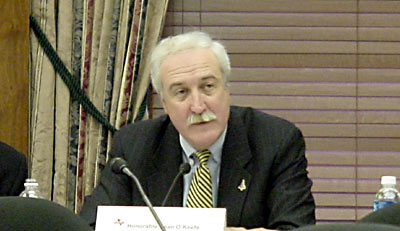Bush’s exploration vision: the real costby Taylor Dinerman
|
| “NASA exists and it is not going to be abolished,” said Walker. “The question for the public and the nation’s leader is, ‘Will it serve any purpose beyond its own narrow interests?’” |
The Exploration Vision is the obvious answer. This plan is going to send robots and humans into the solar system and lay the groundwork for humanity to spread throughout this small part of our galaxy. The strategy, as laid out by NASA, may be subject to legitimate quibbles. For example, it may put too much emphasis on Mars as a long-term goal and not enough on the Moon as a short- to medium-term objective. In the end, having an integrated set of goals and programs is far better than the uncoordinated, disconnected, and wasteful practices of the past thirty years.
Since that decision is essentially behind us, the problem is how to implement it or, in the jargon of the commission, to “enable” it. Indications are that they are going to deal with two issues that NASA and the advocates of the Vision will have to address. The first is how to engage the public and how to get and maintain bipartisan support for the Vision over several decades. The second is how to transform NASA into an organization capable of carrying out the missions entrusted to it.
It is this second issue that Sean O’Keefe has been wrestling with since he became administrator. Dan Goldin probably saved the agency from complete disintegration in the early 1990s, but was unable to begin the kind of top-to-bottom reform that was needed. He simply lacked the political support. In contrast, O’Keefe is a reformer rather than a “space guy.” The Vision is more or less what the “space guys” have been calling for since Apollo. However, it is based on the premise that it will be “sustainable and affordable.” The consensus seems to be emerging that NASA, in its current form, cannot do the job.
| If the Aldridge Commission suggests a way to simplify NASA’s command structure, they will be making a good start at reforming the agency. |
This is no real surprise. NASA has been slowly going downhill. Since the 1970s, it has been building bureaucratic structures and adding missions that may or may not have to do with its primary mission. In the late 1980s, after the Challenger disaster, the Ride Commission suggested that the agency concentrate its efforts in four areas: Aerospace Technology Development, Earth Science (“Mission to Planet Earth,” as it was then called), Space Science, and Human Exploration of the Solar System. While NASA is still basically structured this way, there have been so many new additions, such as the Education Enterprise and the addition of the Exploration Systems Office, that the lines of authority and of actual control are so complex as to defy the strength of mortal men to decipher them.
If the Aldridge Commission suggests a way to simplify NASA’s command structure, they will be making a good start at reforming the agency. If, however, they just reproduce the kind of mindless “downsizing” that was a big corporate fad in the 1990s, then they will be setting the agency up for more failures. Just as the Army needs more NCOs, NASA needs more, not less, middle management. The new safety office is a step in the right direction, but they also need a new, and clearly established, way to demarcate those areas of new, cutting edge science and technology, where risk taking should be encouraged, and those well-understood systems where tight quality and cost controls are appropriate.
The case for the Vision will be debated by the public and by the Congress over the next couple of years. The cost will be one of the most critical elements. NASA does need some extra money, but it should not expect unlimited amounts. America has other priorities. The extra 600 million, or so, that the Administration is seeking for 2005 is barely the cost of three or four days operations in Iraq. One of the witnesses at the hearings made the point that this is really about “hope for the future.” Space exploration is the only way we can ensure a challenging enough mission for America’s brightest scientists and engineers.
America depends on its position as the world leader in science and technology. Space exploration and exploitation is a major driving force in advancing the frontiers of knowledge. Every time the US gives up on a major aspect of this effort, another nation or alliance takes up where we dropped the ball. In particle physics, the loss of the supercollider project has relegated America to a back seat in the quest to understand the structure of matter. We cannot afford to have the same thing happen in space.
